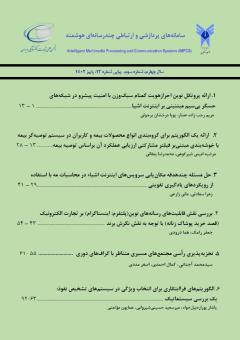تجزیه پذیری راسی مجتمع های مسیری متناظر با گراف های دوری
محورهای موضوعی : پردازش چند رسانه ای، سیستمهای ارتباطی، سیستمهای هوشمندسید محمد آجدانی 1 , کمال احمدی 2 , اصغر مددی 3
1 - استادیار، گروه ریاضی، واحد زنجان، دانشگاه آزاد اسلامی، زنجان، ایران
2 - استادیار، گروه ریاضی، واحد زنجان، دانشگاه آزاد اسلامی، زنجان، ایران
3 - استادیار، گروه ریاضی، واحد زنجان، دانشگاه آزاد اسلامی، زنجان، ایران
کلید واژه: متروئید, تجزیهپذیر رأسی, کوهن مکاولی, پوستهپذیر,
چکیده مقاله :
تکجملهایها پل ارتباطی بین جبر جابجایی و ترکیبیات هستند. اگر ∆ یک مجتمع سادکی روی n راس باشد آنگاه به دو صورت می توان به مجتمع سادکی ∆ ایدهآلهای تکجملهای خالی از مربع نظیر کرد. یکی از این ایدهآلها، ایدهآل استنلی-رایزنر ∆ _I میباشد که مولدهایش متناظر با ناوجههای ∆ هستند و دیگری ایدهآل وجهوارهای (∆ )I است که تعمیمی از ایدهآلهای یالی گرافها است و مولدهایش متناظر با وجهوارههای ∆ میباشند. در جبر جابجایی ترکیبیاتی با استفاده از خواص ترکیبیاتی مجتمعهای سادکی، گرافها، ابرگرافها و ... به مطالعه خواص جبری ایدهآل وابسته به این اشیا ترکیبیاتی میپردازند. یکی از مسائل جذاب در جبر جابجایی ترکیبیاتی که مورد مطالعه محققین زیادی قرار گرفته است، تجزیهپذیری راسی مجتمعهای سادکی است. فرض کنید Gیک گراف ساده و (G)t_∆ یک مجتمع سادکی با وجهوارههای متناظر با مسیرهایی به طول t در گراف G باشد (t≥2). همچنین فرض کنید C_n یک گراف دوری به طول n باشد. در این مقاله نشان داده میشود که (C_n)t_∆ متروئید، تجزیهپذیر راسی ، پوستهپذیر و کوهن مکاولی است اگر و تنها اگر n=t یا n=t+1.
Introduction: Monomials are the link between commutative algebra and combinatorics. With a simplicial complex ∆, one can associate two square-free monomial ideals: the Stanley-Reisner ideal I_∆, whose generators correspond to the non-faces of ∆, or the facet ideal I(∆), which is a generalization of edge ideals of graphs and whose generators correspond to the facets of ∆. The facet ideal of a simplicial complex was first introduced by Faridi. Let G be a simple graph. The edge ideal I(G) of a graph G was first considered by R. Villarreal. He studied the algebraic properties of I(G) using a combinatorial language of G.
Method: In combinatorial commutative algebra, one can attach a monomial ideal to a combinatorial object. Then this ideal's algebraic properties are studied using the combinatorial properties of the combinatorial object. One of the interesting problems in combinatorial commutative algebra is the vertex decomposability of simplicial complexes, which many researchers study. In this abstract, we recall some definitions which will be needed later. A simplicial complex ∆ over a set of vertices V={x_1, … ,x_n} is a collection of subsets of V , with the property that {x_i }∊∆, for all i and if F∊∆, then all subsets of F are also in ∆ (including the empty set). An element in ∆ is called a face of ∆. The dimension of a face F of ∆, dimF, is |F|-1 where |F| is the number of elements of F. The maximal faces of ∆ under inclusion are called facets of ∆. The dimension of the simplicial complex ∆, dim∆, is the maximum of dimensions of its facets. If all facets of ∆ have the same dimension, then ∆ is called pure. Let Ƒ(∆)={F_1, … , F_q } be the facet set of ∆. It is clear that Ƒ(∆) determines ∆ completely and we write ∆=.
Results: Let G be a simple graph, and ∆_t (G) be a simplicial complex whose facets correspond to the paths of length t in G (t≥2). We show that ∆_t (C_n ) is matroid, vertex decomposable, shellable, and Cohen-Macaulay if and only if n=t or n=t+1, where C_n is an n-cycle.


